My Picks For Best Metal Detector Pinpointers UK (2025)

Written by Piotr Lesniewski
Detectorist • Scotland
As an Amazon Associate we earn commission from qualifying purchases. Read our full Affiliate Disclosure.
A pinpointer is essentially a small, handheld metal detector. Its job is to precisely locate a target after your main detector has given you a signal indicating its general area.
Think of your main metal detector as the wide beam searchlight, and the pinpointer as the laser beam that zeros in on the treasure.
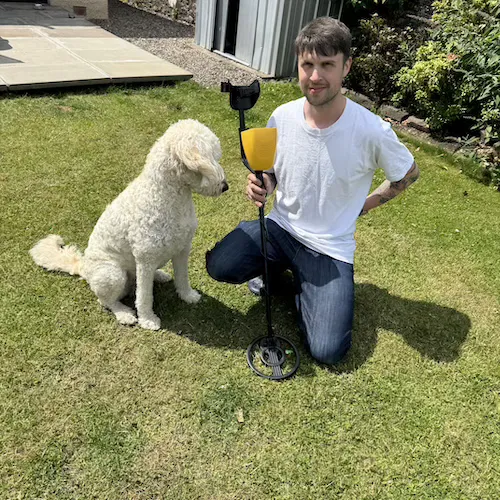
I vividly remember my early days out detecting without one.
It felt like I was excavating craters big enough to lose a badger in, all for a tiny Roman grot or a Victorian button! The moment I got my first pinpointer, the game completely changed.
Suddenly, my holes were smaller, I was recovering targets in a fraction of the time, and there was far less head-scratching and muttering under my breath.
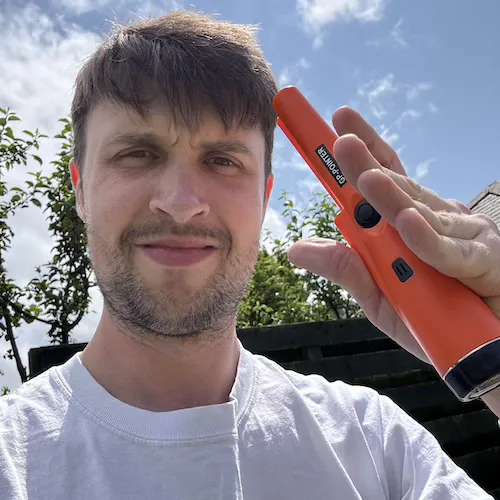
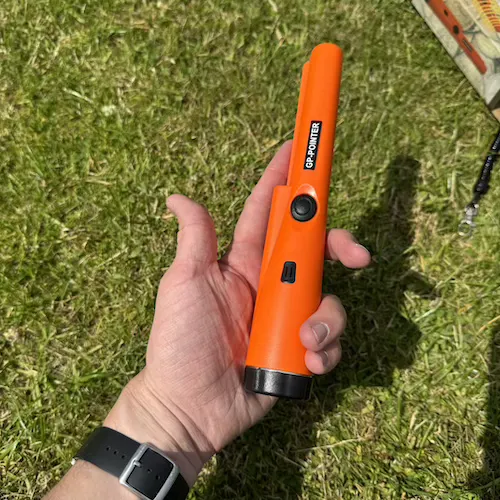
It’s not just about finding stuff; it’s about the feeling of success, and a pinpointer delivers that satisfying “aha!” moment much more quickly, which is absolute gold for keeping new folks, and even us old hands, hooked on the hobby.
Best Metal Detector Pinpointer Picks for 2025
Right, let’s get down to brass tacks. I’ve handled, sold, and used more metal detector pinpointers than I’ve had hot dinners.
For 2025, especially for you lot just starting out in the UK, these are the ones I’d put my money on. What one person calls ‘value‘, another might see differently.
That’s why I’ve tried to explain my reasoning for each pick, so you can see which lines up with your own priorities and budget.
Nokta AccuPOINT
Best High-End Pinpointer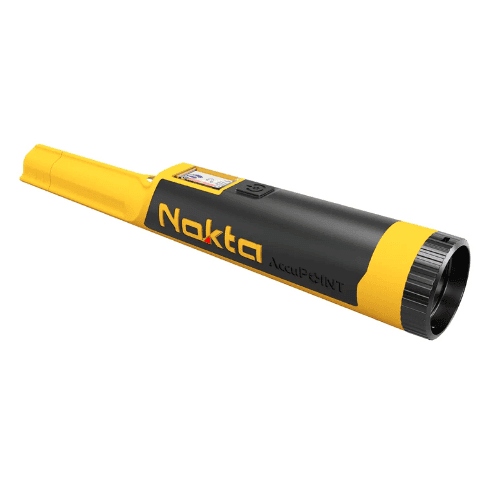
As an Amazon Associate we earn from qualifying purchases.
I Recommend This If...
- The combination of a colour LCD, Bluetooth audio, and useful discrimination tones is currently unparalleled in the pinpointer market.
- The ability to get an audible clue about whether a target is ferrous or non-ferrous before you even see it can significantly reduce the amount of unwanted iron you dig, especially on old, contaminated sites.
- The rechargeable battery is a huge plus, and the clear, bright display makes it a genuine pleasure to use and adjust.
- This is a cutting-edge piece of detecting technology that will serve you exceptionally well for many years to come, adapting to your growing skills and needs.
Best High-End Pinpointer (Worth the Investment!): Nokta AccuPOINT
Now, if your budget can stretch a bit further and you’re after the latest technological advancements and a host of bells and whistles, then the Nokta AccuPOINT is a seriously impressive piece of kit.
Nokta has been making massive waves in the metal detecting world over the last few years, and this pinpointer is a prime example of why they’re gaining such a strong reputation.
Powered by a built-in 1650mAh Lithium Polymer rechargeable battery, offering approximately 25 hours of use on a single charge.
It conveniently charges via a modern USB Type-C connection. Finally, proper rechargeable tech in a top-flight pinpointer!
It’s absolutely packed with features that, until recently, were simply unheard of in a handheld pinpointing device. I’ve been thoroughly impressed with its performance in the field, its robust build, and the sheer amount of control and information it provides to the user.
This is where it truly shines.
It has a vivid Color LCD Screen that displays battery life, sensitivity level, current mode, and more. It also features Bluetooth connectivity for pairing with wireless headphones.
Frequency Shift option to prevent interference with your main detector or other nearby pinpointers, a Lost Alarm, a bright LED Flashlight, and a replaceable tip protector to prolong its life.
That LCD screen is crystal clear and makes navigating the settings an absolute doddle.
DR. ÖTEK MT6 Pro
Best Mid-Range Pinpointer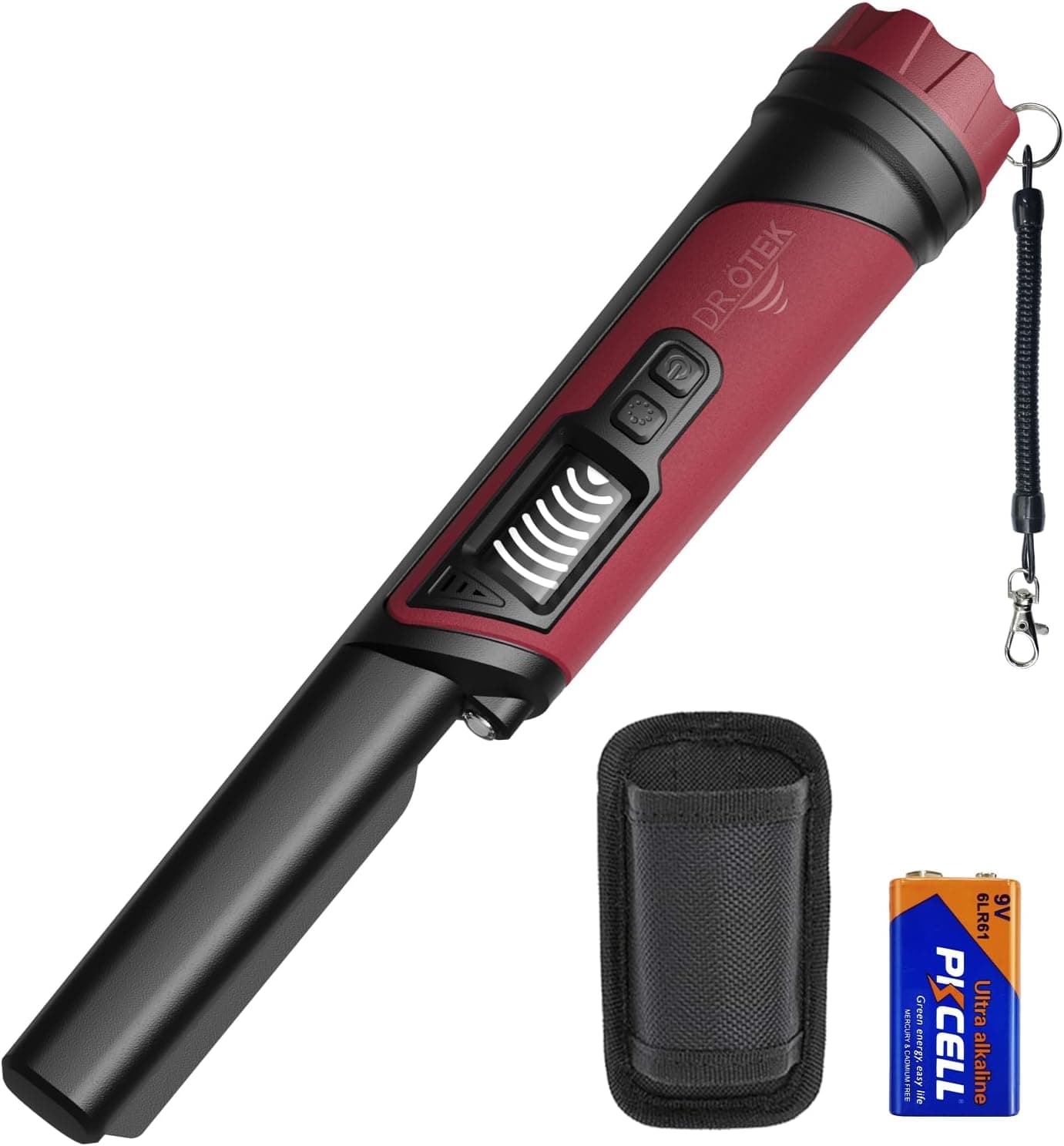
As an Amazon Associate we earn from qualifying purchases.
I Recommend This If...
- Get the benefit of visual target signal feedback without having to stretch to a premium-priced pinpointer.
- The dedicated interference cancellation feature is a real boon, particularly useful if you detect near electric fences, mobile phone masts, or with a group of other detectorists.
- No need to worry about sudden downpours or detecting in damp soil and shallow water.
- It’s a significant step up from the most basic budget models, offering genuinely useful features that will enhance your detecting experience.
Best Mid-Range Pinpointer (The Sweet Spot!): DR. ÖTEK MT6 Pro
DR. ÖTEK has really come on strong in the detecting market, consistently offering pinpointers and detectors with features you’d typically expect to find on much pricier models, but at a far more wallet-friendly price point.
The MT6 Pro is a fantastic example of this philosophy.
It’s got a clear LCD screen, it’s properly IP68 waterproof, and it even boasts an interference cancellation feature – all things that make a tangible difference to your experience out in the field.
For someone who wants more than just the basic functions but isn’t quite ready to shell out for a top-tier, high-end model, this DR. ÖTEK MT6 Pro strikes a brilliant balance and represents a real sweet spot in the market.
Comes with an LCD Screen that displays the signal strength of the target, an “Exclusive Interference Cancellation” function, true 360° detection around the probe, a scaled design on the body to help assess target depth, and a built-in scraping edge.
That interference cancellation is a particularly big plus at this price point, as it can make a real difference on sites with electrical interference or when detecting close to other machines.
For many, spending that little bit extra on a mid-ranger like this is a smart move.
You get features that genuinely help improve your finds and enjoyment, without the significant financial outlay of the top-end units.
SUNPOW Pinpointer
Best Budget Pinpointer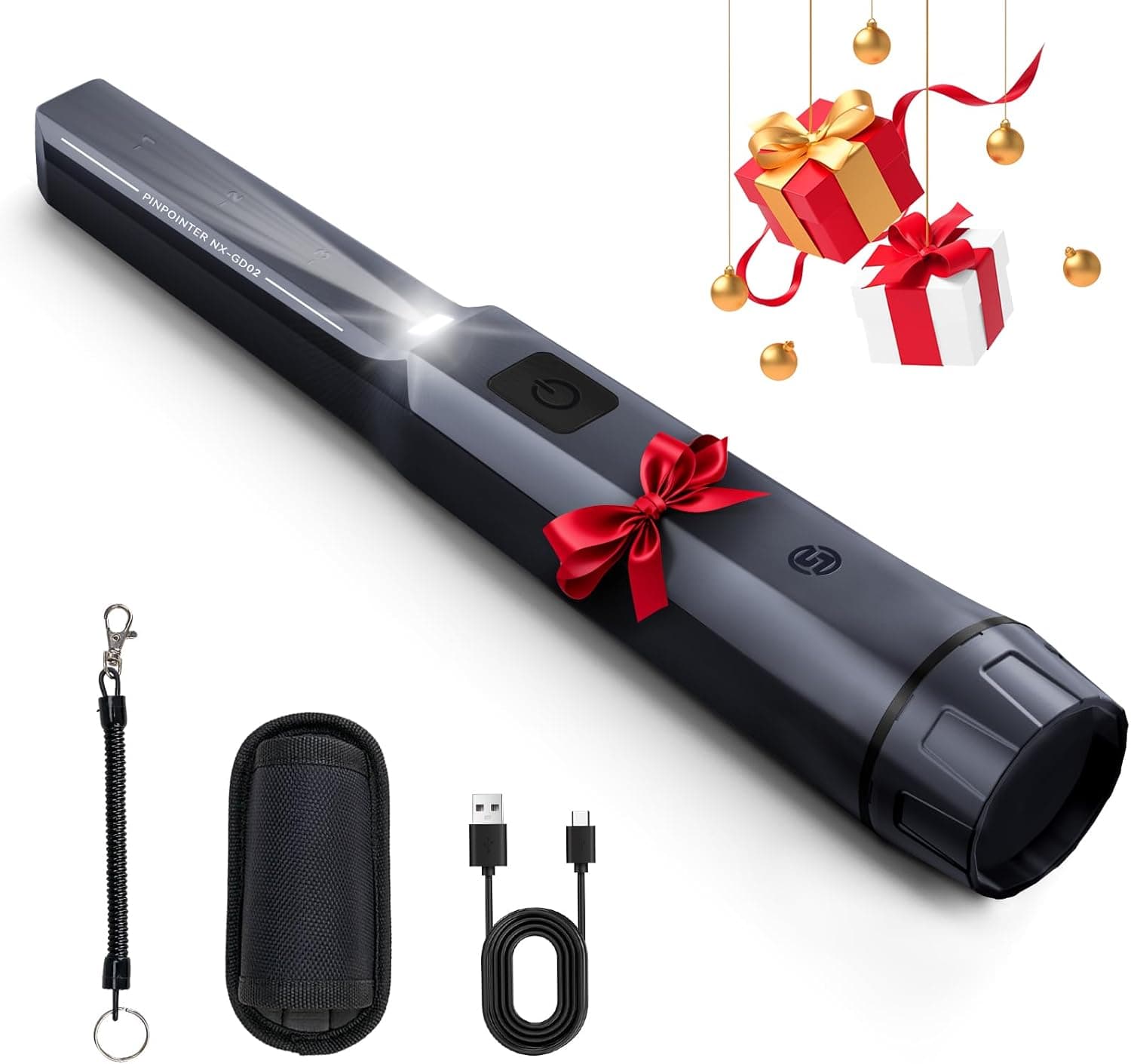
As an Amazon Associate we earn from qualifying purchases.
I Recommend This If...
- It gets you started with an essential piece of detecting kit for a minimal financial outlay.
- Many models in this bracket handle damp British conditions remarkably well for their cost.
- It will help you locate targets more precisely and save you a significant amount of digging time compared to not using one.
- They are popular for a reason – they are accessible and provide a functional introduction to pinpointing for many newcomers to the hobby.
Best Budget Pinpointer (Great Start Without Breaking the Bank!): SUNPOW IP68 Waterproof Handheld Pin Pointer Wand
If you’re on a really tight budget, or perhaps you’re just curious and want to dip your toe in the water to see if a pinpointer helps without committing much cash, then the basic SUNPOW pinpointers are incredibly popular, and for good reason.
You’ll often see these types of pinpointers with thousands of positive reviews on Amazon. They do the fundamental job of pinpointing targets, many are surprisingly waterproof enough for most typical UK conditions (often rated IP68), and they absolutely won’t break the bank.
It’s definitely a no-frills option, but it will certainly help you find your targets much faster and with less digging than going without one. You’ll see a lot of very cheap pinpointers out there.
Some are okay for the absolute basics, but if a deal looks too good to be true, offering loads of advanced features for a tenner, it’s wise to be a bit wary. Sometimes, paying just that little bit more for a known name in the budget category or a well-reviewed model from a brand like SUNPOW or DR. ÖTEK is a smarter long-term move than opting for the absolute rock-bottom cheapest you can find.

What to Look For When Choosing Your First Metal Detector Pinpointer:
Alright, so you’ve seen my picks for the best metal detector pin pointers in 2025. But maybe you’re looking at another model that’s caught your eye, or you just want to understand a bit more about what makes a good pinpointer tick.
As someone who sells these tools day in, day out, and uses them regularly, here’s what I always tell my customers to consider.
My aim here is to give you the knowledge to look at any pinpointer and decide if it’s right for you, not just the ones I’ve highlighted.
This checklist should help demystify some of the technical specifications and help you make an informed decision that goes beyond just the price tag or brand name.

Waterproofing (Absolutely Essential for UK fields! )
Honestly, for detecting anywhere in the UK, this is a non-negotiable feature for me.
Our weather is, shall we say, ‘wonderfully unpredictable‘! You will get caught in the rain, you’ll want to detect on dew-soaked grass, on damp ploughed fields, and maybe even venture onto beaches or beside streams.
We’re not detecting in sunny California, are we?
We need gear that can handle a bit of British mud and drizzle! Look for an IP (Ingress Protection) rating.
IP68 is the gold standard for pinpointers, generally meaning it can be fully submerged (the specific depth and duration can vary, so always check the manufacturer’s specs – examples include the Nokta AccuPOINT at 3m , Minelab PRO-FIND 40 at 3m , DR. ÖTEK MT6 Pro at 3m , and even many budget SUNPOW models claim IP68 ).
Even an IP66 or IP67 rating offers good water resistance against heavy splashes and rain, which might be sufficient if you don’t plan on submerging it.
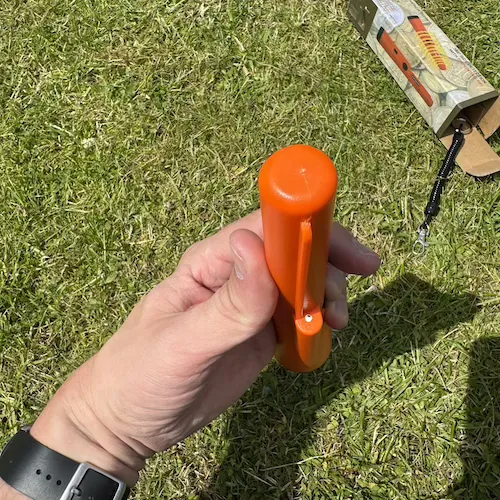
Sensitivity (And why adjustable is a real bonus )
You want your pinpointer to be sensitive enough to easily pick up small targets like tiny coins or fragments, but not so overly sensitive that it’s constantly giving false signals on heavily mineralised ground or tiny bits of coke or iron that your main detector has already (hopefully) discriminated out.
Having adjustable sensitivity levels (like the 5 on the Minelab PRO-FIND 40 , or 9 on the Nokta AccuPOINT ) is a massive plus.
This allows you to fine-tune its performance to the specific conditions of the site you’re on, or to help you zero in on a very small target when there might be other metallic items nearby.
Alert Types (Beep, Vibrate, or Both?)
Most pinpointers will offer audio beeps, vibration, or a combination of both as you get closer to a target. I personally like having the option of both.
Vibration is excellent if you want to be discreet (perhaps you don’t want to spook nearby wildlife, or you’re trying to be quiet near a public footpath), or if you’re wearing headphones with your main detector and might not hear the pinpointer’s audio.
Some of the more advanced pinpointers, like the Nokta AccuPOINT and Minelab PRO-FIND 40 , even offer different audio tones to help you distinguish between ferrous (iron) and non-ferrous targets, which can be a real time-saver.
Battery Life & Type (The classic 9V vs. modern Rechargeable debate)
Traditional 9V batteries are still very common in pinpointers. They are readily available, and if you carry a spare, you’re pretty much guaranteed to be good to go for a full day’s detecting, or even several.
Battery life can vary significantly; for instance the Minelab PRO-FIND 40 suggests about 20 hours nominal.
However, rechargeable models, typically using Lithium-ion or Lithium Polymer batteries, are becoming increasingly popular and are standard on higher-end units like the Nokta AccuPOINT and some newer SUNPOW models like the NX-GD01.
These are very convenient as you don’t have to keep buying disposable batteries, which saves money in the long run and is better for the environment.
Just make sure the stated battery life will comfortably last your typical detecting session, or check if it can be easily topped up in the car via USB.
The Nokta AccuPOINT, for example, offers a very respectable 25 hours or so per charge.
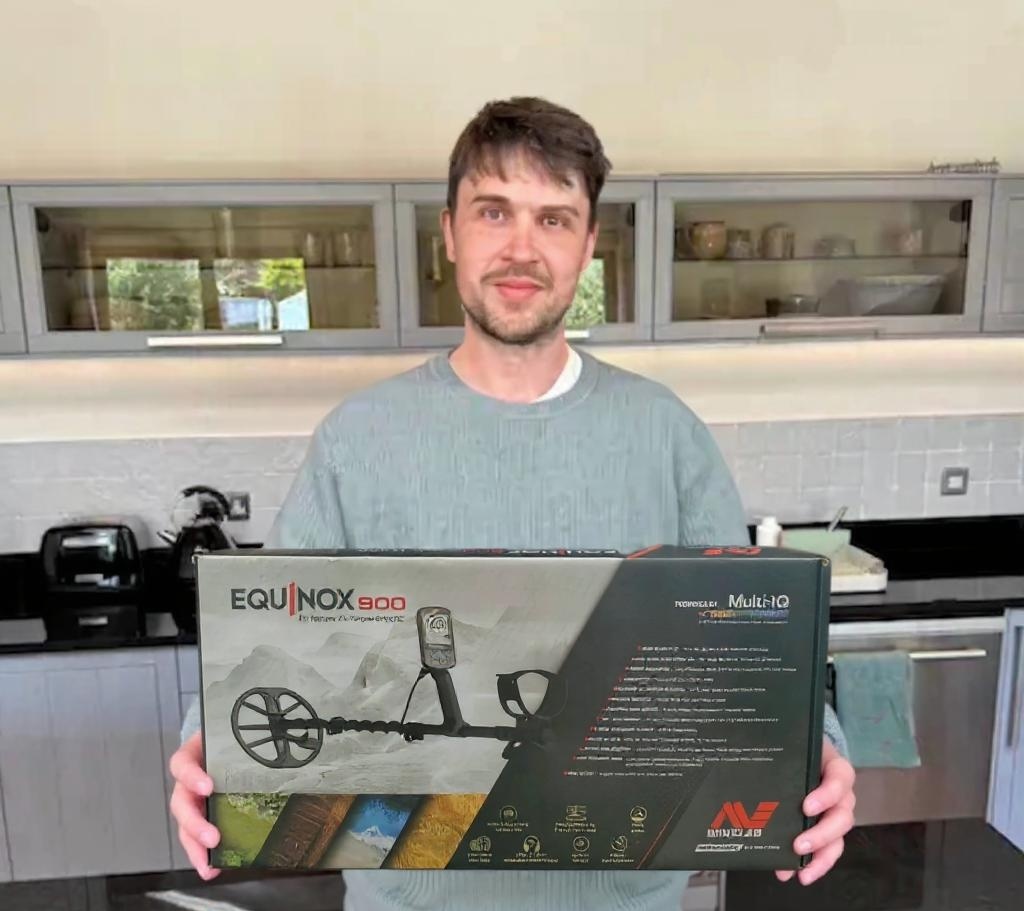
Build Quality & Durability (It’s going to take some knocks!)
Let’s be honest, your pinpointer is going to live a hard life. It’ll be poked into gritty soil, scraped against stones, dropped in the mud, and generally get bumped around.
You need one that feels solid and is built to withstand this kind of treatment. Look for a robust casing made from durable materials.
Well-established brands like minelab have a strong reputation for building tough gear.
Some models, like the Nokta AccuPOINT, also come with replaceable tip protectors, which is a great feature as the tip is often the area that sees the most wear.
Ease of Use (You want to be detecting, not wrestling with a complicated gadget)
Especially when you’re a beginner, simplicity is often key.
You want a pinpointer that you can pretty much turn on and use straight away without having to consult a hefty manual every five minutes.
Many excellent pinpointers feature straightforward single-button operation for all major functions.
Look for clear, unambiguous indicators and alert signals that are easy to understand.
You want to power it on and get straight to finding those hidden goodies!
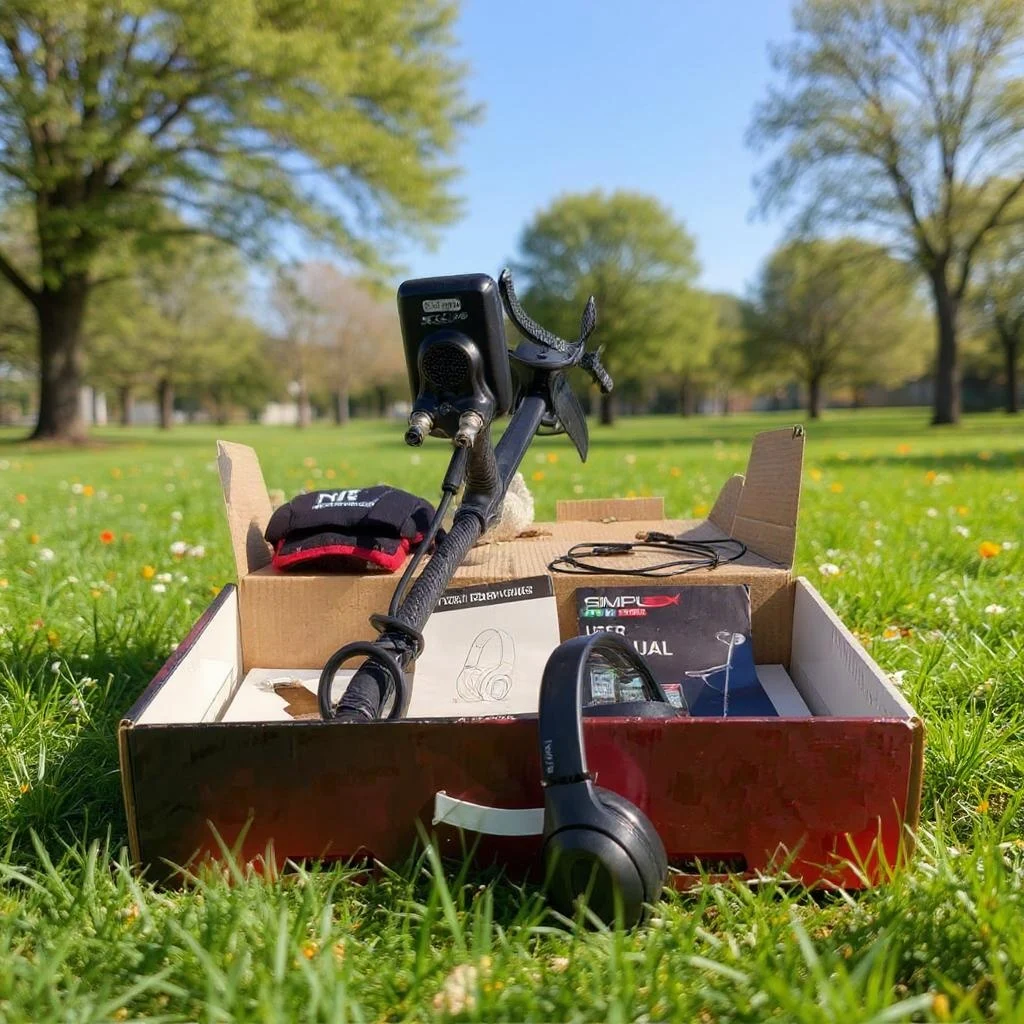
Benefits of Using a Pinpointer Are Huge, especially when you’re starting out:
Saves You Precious Time
This is the big one. A pinpointer drastically cuts down the time you spend searching for a target within the dug plug of earth or in the hole itself.
You’ll spend less time on your knees, sifting through soil with your fingers, and more time swinging your detector to find that next exciting signal.
Less time faffing about chasing an elusive target means more time detecting the next one.
Improves Accuracy & Minimises Damage
Because a pinpointer allows for such precise target location, you can dig much smaller, neater holes.
This is absolutely crucial for responsible metal detecting. It shows respect for the landowner’s property – usually farmland here in the UK – and helps preserve the archaeological context of your finds.
More importantly, it significantly reduces the risk of damaging what you’ve found. There’s nothing worse than scraping a beautiful hammered silver coin with your spade because you were digging too broadly.
A pinpointer helps you avoid that heartbreak by letting you excavate those last few inches with care.
Using a pinpointer isn’t just good for you; it’s good for the reputation of all detectorists.
Clean, small digs mean happy farmers, and happy farmers mean more beautiful permissions for us all to explore!
Works in Tight Spaces
There will be times when your main detector’s coil, no matter how small, just can’t get close enough to a target.
Think targets hidden amongst dense tree roots, in tight crevices in old stonework, or even just checking the sidewalls of the hole you’ve dug.
Your pinpointer, with its slim profile, can get right in there.
Enhances Target Recovery
Small items like hammered coins, tiny buckles, or delicate pieces of jewellery can be incredibly difficult to spot with the naked eye, even when they’re out of the ground.
Your pinpointer will sing out when it’s near them, even if they’re caked in mud.
Sometimes the target isn’t in the plug you’ve removed at all, but still lodged in the side-wall of the hole; your pinpointer will sniff it out when your eyes might miss it!
This immediate, tangible success in locating the item is a massive confidence booster for beginners.
Repeatedly failing to find a target after digging can be disheartening, but a pinpointer changes that.
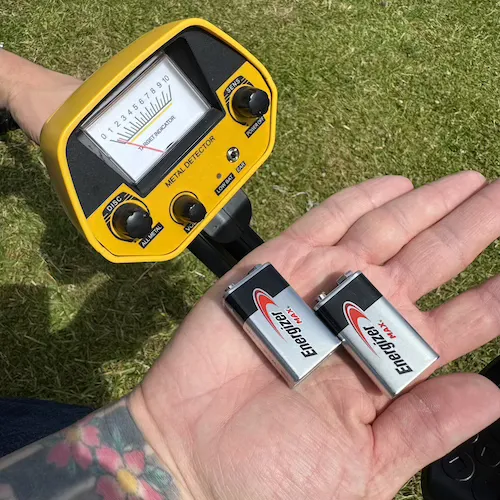
My Top Tips for Using Your New Pinpointer Like a Pro (Well, Almost!)
Got your pinpointer? Brilliant! That’s a massive step towards more efficient and enjoyable detecting.
Now, let’s talk about using it effectively. It’s generally pretty straightforward, but a few handy tips from an old hand like me can save you some time, help you get the most out of your new tool from day one, and prevent a few common beginner mistakes.
Think of it like learning to ride a bike – a few good metal detector tips get you pedalling smoothly much quicker!
Getting Started: Basic Operation
First things first,
read the manual!
Yes, I know, it’s tempting to just rip it out of the box and start waving it about, but even for the simplest pinpointers, a quick skim of the instructions can reveal useful features or operational quirks you might otherwise miss.
Get to know its
alert signals
. How do they change as you get closer to a metal object? Most will increase in intensity (faster beeps or stronger vibrations). A great way to familiarise yourself is to test it on a coin placed on the ground above the surface before you even dig your first hole.
Understand its
detection field
. Does it primarily detect from the very tip, or does it also detect along the sides of the probe? Most modern pinpointers offer 360-degree detection around the lower part of the probe , which is very useful for scanning the sides of a hole.
Techniques for Pinpointing Accurately in the Plug and Hole :
How to Avoid Damaging Your Precious Finds:
Once your pinpointer is screaming and you know you’re right on top of the target,
go gently!
Don’t just aggressively stab the pinpointer into the ground or use it to forcefully lever things out.
Use your fingers (ideally gloved!) or a small, non-metallic digging tool (like a tough plastic trowel, a finds pick, or even a wooden skewer) to carefully excavate the last bit of soil around the target.
Remember, many historical finds, especially older coins and artefacts, can be incredibly fragile. The pinpointer gets you to within a whisker of it; the final recovery stage should always be careful, patient handwork.
Looking After Your Pinpointer (TLC for a Trusted Tool):
Keep it clean. After each detecting session, wipe off any mud, dirt, and moisture, paying particular attention to the area around the battery cap if it’s a waterproof model, to ensure the seal remains effective.
Check your battery levels regularly, and don’t store your pinpointer for long periods with a nearly dead or potentially leaking battery still inside.
If your pinpointer is waterproof and you’ve been using it in saltwater (
beach detecting
), it’s always a good idea to give it a quick rinse in fresh water afterwards to remove any salt deposits that could cause corrosion over time.
Treat it well, and it’ll treat you well for many seasons to come. A little bit of care and maintenance goes a long way in ensuring your pinpointer works reliably hunt after hunt. This is especially true if you’ve invested in a mid-range or high-end model; looking after it helps ensure you get the full value from that investment over its lifespan.
Quick Summary
| Rank | Detector | Amazon Link |
|---|---|---|
| #1 | Nokta AccuPOINT Best High-End Pinpointer | View On Amazon |
| #2 | DR. ÖTEK MT6 Pro Best Mid-Range Pinpointer | View On Amazon |
| #3 | SUNPOW Pinpointer Best Budget Pinpointer | View On Amazon |
As an Amazon Associate we earn from qualifying purchases.
Final Thoughts and Happy Hunting!
So there you have it – my comprehensive rundown on what I believe are the best pinpointers for beginners venturing into the wonderful world of metal detecting here in the UK for 2025, along with my top tips on how to choose one and get the most out of it once you have.
Choosing the best metal detecting pinpointer in 2025, one that suits your budget and the types of sites you’ll be searching, can genuinely make a huge difference to your enjoyment and success in this amazing hobby.
Don’t be afraid to invest a little if your budget allows – a good quality, reliable pinpointer will serve you well for many exciting hunts to come.
Remember, at its heart, metal detecting is all about the thrill of the chase, the connection to history you unearth with every find, and the simple pleasure of enjoying the great British outdoors.
Your pinpointer is just a very clever and useful tool to help you do all of that more effectively and responsibly.
We’re all in this together, us mudlarks and treasure seekers, united by the buzz of discovery.
The best find is always the next one, so the most important thing is to get out there, always detect responsibly (fill your holes neatly!), respect the land and the Countryside Code, and, above all, have fun.
If you’ve got any questions, you usually know where my shop is! (Or, if this were a blog, I’d say drop a comment below).
Happy hunting, and may your finds pouch always be heavy with interesting discoveries!
Author Profile

Piotr Lesniewski
"Digging up the past, one signal at a time."
Polish-born, Scotland-based, and obsessed with the beep. My passion began decades ago, exploring fields with my Dziadek (grandfather). Now, with over 10 years of digging under my belt, I'm here to share everything I've learned—unfiltered and unbiased—to help you unearth your own piece of history. No sales pitches, just real field experience.